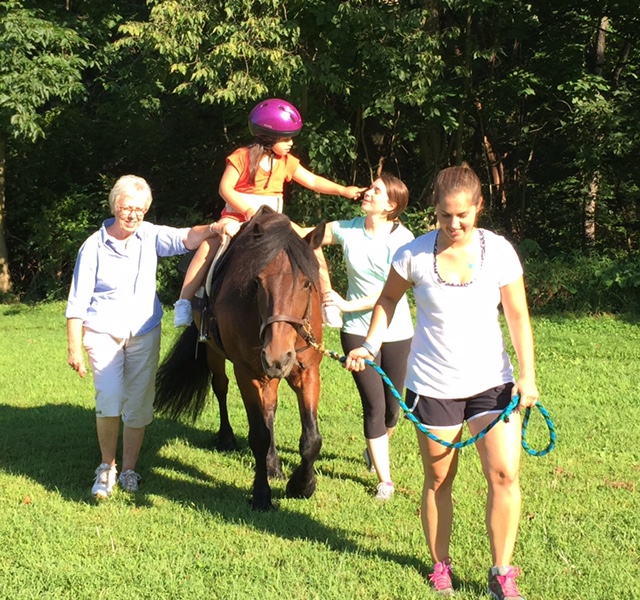
As anyone who is well acquainted with me knows, I’m not just a top Paoli Realtor; I’m also a mother of eight, and one who knows firsthand about both the challenges and the joys that come along with having children who have special needs.
I always appreciate it when I see others find new and exciting ways to help anyone, especially children, better understand themselves or the world around them – which is exactly why today, I’m setting aside the Real Estate topics to talk to you about Quest Therapeutic Services’ marvelous Hippotherapy program.
I found out about this program through my brother, Bob Byrnes, who is a licensed Occupational Therapist currently in training to transition from working with adults to becoming a hippotherapist for children at Quest. He was able to give me a lot of great firsthand info, with a perspective that only someone who participates in those sessions could get.
What Is Hippotherapy?

The word itself does sound a little silly – and no, hippotherapy is not therapy for or with hippos…but it is close. Hippotherapy is, as Bob puts it, “occupational, physical or speech therapy ‘with the help of a horse,’ hippo being Greek for horse.” The applications of hippotherapy – also known as Equine Assisted Therapy, or EAT – are many, especially when it comes to children with neurological or developmental disorders such as autism, cerebral palsy, Downs syndrome, and more.
During a session of hippotherapy, a child will get the opportunity to ride on a horse with a licensed handler. According to Quest’s website, this “has been shown to be one of the most efficient and effective treatments to improve postural control, balance and walking in patients with motor disorders… The major aims of hippotherapy include mobilizing the pelvis, lumbar spine and hip joints, normalizing muscle tone, developing head and trunk postural control and equilibrium reactions in the trunk.”
In other words, hippotherapy can help kids who have trouble with motor skills like walking, balancing, or even sitting up straight learn to better control their own movements, in a way that is natural and feels less like instruction and more like tuning into the body’s own intuitions. Children with motor or movement issues, and even those recovering from traumatic brain injury, can benefit from learning to work with the natural movements of a horse as it walks.
Bob described a typical session like this:
“Experienced horse handlers take control of the horse from in front, leading the horse in whatever direction and at what pace the therapist requests. The therapist walks adjacent to the saddled child, providing hands-on positioning of the child in the saddle. The direction and pace can change at unpredictable moments in the course of riding, which is the therapist intentionally engaging the child’s body’s auto-response to those changes.

“Treatment sessions at Quest are scheduled for 45 minutes, typically the first half of the session on a horse followed by activity or other exercises depending upon the needs of that child.”
Those with motor or coordination issues aren’t the only groups that can benefit from hippotherapy, however. Children with behavioral or social disorders, anxiety, and even neurodivergent children who don’t have trouble with motor skills, like level one autism (formerly known as Aspberger’s) or ADHD, are also helped.
According to Zoe Kessler for ADDitute Magazine, these treatments work due to “a horse’s uncanny ability to mirror the emotions and attitudes of his handlers.” In this way, working with a horse can teach a child to better observe and evaluate their own behavior – a task which can often be made difficult by the racing thoughts of anxiety or ADHD, or the uncommon perspectives that come with autism.
There are actually other versions of this therapy that exist – the one described in the aforementioned article was one designed to help adults with ADHD improve their communications skills, among other things. But the ones done at Quest are specifically geared towards children.
How Does Hippotherapy Help?

For children with motor impairments or challenges, it’s relatively simple to explain the benefits. On Quest’s website, they explain:
“The major aims of hippotherapy include mobilizing the pelvis, lumbar spine and hip joints, normalizing muscle tone, developing head and trunk postural control and equilibrium reactions in the trunk. The horse’s movement has a therapeutic effect on the child because it imparts a precise, repetitive pattern of movement very similar to the movement of a person’s pelvis during normal walking.”
When it comes to children with other issues, such as behavioral problems or problems with attention or anxiety, the effects of hippotherapy are a little harder to explain – but not impossible.
Though it has not yet been widely researched, one early study has suggested that EAP or hippotherapy may be a more effective therapeutic tool for children than traditional, school-based counseling interventions.
Given that there’s not a lot of research on this, there is no concrete way to say why it works so well, but Kit Muellener, founder of Hope Ranch, a similar EAT program in Minnesota, that it may have something to do with the “instant feedback” horses can provide, due to the highly reactive natures of their personalities. They can mirror people in uncanny ways, much more quickly than any layman might expect.

“What’s more, clients feel that they’ve achieved something on their own, rather than being told to do something by a parent or teacher.” Muellener told ADDitude. “A 1,500-pound animal responds the way you want him to because you were able to focus. So you’ve accomplished something that you wanted to do, versus doing something somebody else wanted you to do.”
If this research trend continues, some may be baffled as to why these treatments work so much better with children than traditional therapies, but Bob makes an excellent point to that end:
“With adults, you are usually starting out from ‘normal’ and later having to work against the impact of aging, with the onset of a disease or trauma; adults must adjust to managing and recovering from declines. With children, they and their parents usually have to deal with an abnormal condition right out of the gate, having to continually work toward some level of ‘normal’ rather than coming from it as with the adult.”
What this also means is that adults usually have an end goal in mind for their therapy – an idea of what aspects of themselves they need to improve in order to better interact with the world around them. Children, conversely, are almost never the ones seeking therapy, and so these end goals may not be as clear. It may therefore be simpler for them to learn what they need to the way children normally do – through an organic life experience, guided by adults.
Why Quest?

If any of this interests you, as far as choosing a hippotherapy center for your own child, I think Quest’s landing page makes a strong point as to why they’re the best choice around:
“Quest Therapeutic Services is the only full-time hippotherapy outpatient center serving the Delaware Valley (PA, NJ and DE). We adhere to all PATH safety guidelines and provide direct hands-on participation with your child at all times. Parents and caregivers can watch the sessions in process and they are always encouraged to be active participants in the overall treatment plan.”
And if that doesn’t say enough, this firsthand account from Bob definitely will:
“I recently worked with a eight year old boy who had a significant social anxiety disorder. He also was evaluated with diminished muscle strength, especially in his hands, due to very little physical activity in his daily routine. He is a highly intelligent and inquisitive boy, earning high marks in school.
Though discussions during his time on the horse, it was discovered that he had a great interest in birds. This boy was tasked to begin assembling a wooden bird house, working on it for the second half of each of four treatment sessions; the activity required coordinating eight wooden rectangles, and maintaining focus and a tight grip on a screw driver while tightening over thirty wood screws. When the birdhouse was completed, he proudly took it home where his dad helped him prop it up on a pole, placed out in an open field on the family property.
The boy’s mom called the following day, reporting that in less than 24 hours, an Eastern Bluebird had moved into the birdhouse and had begun building a nest.
A week later, his mom called again, and reported that her son had invited another boy from his school to come to his home in order to “check out” the birdhouse. It was the first time that boy had ever had someone come over to his house to play.”
Bottom Line
There isn’t more concrete evidence than stories like that one. If you have a child in the West Chester area with special needs who doesn’t seem to be responding to regular therapy, or you simply want to give hippotherapy a try with them, Quest is a wonderful place. And if you don’t live in the area but find this tipping the scales ever closer, don’t hesitate to reach out – I’d be more than happy to discuss your wants and needs, as both a mother AND a realtor.



